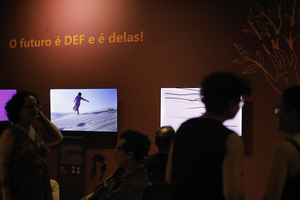Exposições e museus inclusivos: para quê e para quem?
Uma exposição acessível deve estar ciente das diversas deficiências, que são muito variadas, e cada uma com a sua especificidade. É necessário que o ambiente possua alguns recursos de tecnologia assistiva, para que pessoas com deficiência (PcD) possam ter a mesma possibilidade de acesso dos demais visitantes. Tecnologia assistiva (TA) é uma expressão que abrange todos os recursos e serviços destinados a melhorar as habilidades funcionais do PcD, promovendo uma vida independente e a inclusão social. Alguns exemplos são audiodescrição, interpretação em Libras, textos em braille e linguagem simplificada. É urgente superar as barreiras físicas, sensoriais, cognitivas, comunicacionais e atitudinais que impedem o pleno acesso das pessoas às exposições culturais, científicas e educativas. Com essa pesquisa, pretendo contribuir para a difusão de aprendizados e boas práticas para a acessibilidade na expografia. A pesquisa tem o objetivo de investigar se e como projetos expográficos incorporaram a acessibilidade ao longo dos últimos 10 anos, a partir de um diagnóstico de projetos expográficos executados em diferentes museus do estado do Rio de Janeiro. As análises serão realizadas a partir de pesquisas sobre acessibilidade e design universal.
An accessible exhibition must be aware of the many different disabilities, each with its own specific characteristics. It is necessary for the environment to have some assistive technology resources so that people with disabilities (PwD) can have the same access possibilities as other visitors. Assistive technology (AT) is an expression that covers all the resources and services designed to improve the functional abilities of people with disabilities, promoting independent living and social inclusion. Some examples are audio description, interpretation in Libras, Braille texts and simplified language. There is an urgent need to overcome the physical, sensory, cognitive, communication and attitudinal barriers that prevent people from having full access to cultural, scientific and educational exhibitions. With this research, I intend to contribute to the dissemination of lessons learnt and good practices for accessibility in exhibition design. The aim of the research is to investigate whether and how expographic projects have incorporated accessibility over the last 10 years, based on a diagnosis of expographic projects carried out in different museums in the state of Rio de Janeiro. The analyses will be based on research into accessibility and universal design.
